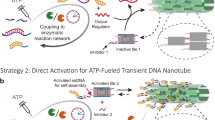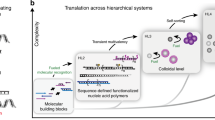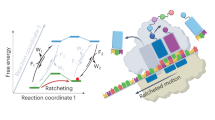Abstract
Multistep synthesis in the laboratory typically requires numerous reaction vessels, each containing a different set of reactants. In contrast, cells are capable of performing highly efficient and selective multistep biosynthesis under mild conditions with all reactants simultaneously present in solution1,2,3,4. If the latter approach could be applied in the laboratory, it could improve the ease, speed and efficiency of multistep reaction sequences. Here, we show that a DNA mechanical device—a DNA walker moving along a DNA track—can be used to perform a series of amine acylation reactions in a single solution without any external intervention. The products of these reactions are programmed by the sequence of the DNA track, but they are not related to the structure of DNA. Moreover, they are formed with speeds and overall yields that are significantly greater than those previously achieved by multistep DNA-templated small-molecule synthesis.
This is a preview of subscription content, access via your institution
Access options
Subscribe to this journal
Receive 12 print issues and online access
$259.00 per year
only $21.58 per issue
Buy this article
- Purchase on Springer Link
- Instant access to full article PDF
Prices may be subject to local taxes which are calculated during checkout



Similar content being viewed by others
References
Hanes, J. & Pluckthun, A. In vitro selection and evolution of functional proteins by using ribosome display. Proc. Natl Acad. Sci. USA 94, 4937–4942 (1997).
Zahnd, C., Amstutz, P. & Pluckthun, A. Ribosome display: selecting and evolving proteins in vitro that specifically bind to a target. Nature Methods 4, 269–279 (2007).
Walsh, C. T. Polyketide and nonribosomal peptide antibiotics: modularity and versatility. Science 303, 1805–1810 (2004).
Sattely, E. S., Fischbach, M. A. & Walsh, C. T. Total biosynthesis: in vitro reconstitution of polyketide and nonribosomal peptide pathways. Nat. Prod. Rep. 25, 757–793 (2008).
Snyder, T. M. & Liu, D. R. Ordered multistep synthesis in a single solution directed by DNA templates. Angew. Chem. Int. Ed. 44, 7379–7382 (2005).
Seeman, N. C. From genes to machines: DNA nanomechanical devices. Trends Biochem. Sci. 30, 119–125 (2005).
Bath, J. & Turberfield, A. J. DNA nanomachines. Nature Nanotech. 2, 275–284 (2007).
Liedl, T., Sobey, T. L. & Simmel, F. C. DNA-based nanodevices. Nano Today 2, 36–41 (2007).
Beissenhirtz, M. K. & Willner, I. DNA-based machines. Org. Biomol. Chem. 4, 3392–3401 (2006).
Yin, P., Yan, H., Daniell, X. G., Turberfield, A. J. & Reif, J. H. A unidirectional DNA walker that moves autonomously along a track. Angew. Chem. Int. Ed. 43, 4906–4911 (2004).
Bath, J., Green, S. J. & Turberfield, A. J. A free-running DNA motor powered by a nicking enzyme. Angew. Chem. Int. Ed. 44, 4358–4361 (2005).
Tian, Y., He, Y., Chen, Y., Yin, P. & Mao, C. D. Molecular devices—a DNAzyme that walks processively and autonomously along a one-dimensional track. Angew. Chem. Int. Ed. 44, 4355–4358 (2005).
Yin, P., Choi, H. M. T., Calvert, C. R. & Pierce, N. A. Programming biomolecular self-assembly pathways. Nature 451, 318–322 (2008).
Omabegho, T., Sha, R. & Seeman, N. C. A bipedal DNA Brownian motor with coordinated legs. Science 324, 67–71 (2009).
Gu, H. Z., Chao, J., Xiao, S. J. & Seeman, N. C. A proximity-based programmable DNA nanoscale assembly line. Nature 465, 202–205 (2010).
Lund, K. et al. Molecular robots guided by prescriptive landscapes. Nature 465, 206–210 (2010).
Gartner, Z. J., Kanan, M. W. & Liu, D. R. Multistep small-molecule synthesis programmed by DNA templates. J. Am. Chem. Soc. 124, 10304–10306 (2002).
Chhabra, R., Sharma, J., Liu, Y. & Yan, H. Addressable molecular tweezers for DNA-templated coupling reactions. Nano Lett. 6, 978–983 (2006).
Chen, Y. & Mao, C. Reprogramming DNA-directed reactions on the basis of a DNA conformational change. J. Am. Chem. Soc. 126, 13240–13241 (2004).
Voigt, N. V. et al. Single-molecule chemical reactions on DNA origami. Nature Nanotech. 5, 200–203 (2010).
Santoro, S. W. & Joyce, G. F. A general purpose RNA-cleaving DNA enzyme. Proc. Natl Acad. Sci. USA 94, 4262–4266 (1997).
Nissen, P., Hansen, J., Ban, N., Moore, P. B. & Steitz, T. A. The structural basis of ribosome activity in peptide bond synthesis. Science 289, 920–930 (2000).
Trobro, S. & Aqvist, J. Mechanism of peptide bond synthesis on the ribosome. Proc. Natl Acad. Sci. USA 102, 12395–12400 (2005).
Snyder, T. M., Tse, B. N. & Liu, D. R. Effects of template sequence and secondary structure on DNA-templated reactivity. J. Am. Chem. Soc. 130, 1392–1401 (2008).
Gartner, Z. J. & Liu, D. R. The generality of DNA-templated synthesis as a basis for evolving non-natural small molecules. J. Am. Chem. Soc. 123, 6961–6963 (2001).
Li, X. Y. & Liu, D. R. DNA-templated organic synthesis: nature's strategy for controlling chemical reactivity applied to synthetic molecules. Angew. Chem. Int. Ed. 43, 4848–4870 (2004).
Tse, B. N., Snyder, T. M., Shen, Y. H. & Liu, D. R. Translation of DNA into a library of 13000 synthetic small-molecule macrocycles suitable for in vitro selection. J. Am. Chem. Soc. 130, 15611–15626 (2008).
Acknowledgements
This work was supported by the Howard Hughes Medical Institute and National Institutes of Health/National Institute of General Medical Sciences (R01GM065865). The authors thank C. Dumelin and Y. Chen for insightful discussions and experimental assistance. The authors are grateful to Y. Shen for assistance with mass spectrometry.
Author information
Authors and Affiliations
Contributions
Y.H. and D.L. conceived and designed the project, analysed the data and wrote the manuscript. Y.H. performed the experiments.
Corresponding author
Ethics declarations
Competing interests
D.L. is a consultant for Ensemble Discovery, a company that uses DNA-templated synthesis for industrial applications.
Supplementary information
Supplementary information
Supplementary information (PDF 1204 kb)
Rights and permissions
About this article
Cite this article
He, Y., Liu, D. Autonomous multistep organic synthesis in a single isothermal solution mediated by a DNA walker. Nature Nanotech 5, 778–782 (2010). https://doi.org/10.1038/nnano.2010.190
Received:
Accepted:
Published:
Issue Date:
DOI: https://doi.org/10.1038/nnano.2010.190
This article is cited by
-
Single-particle combinatorial multiplexed liposome fusion mediated by DNA
Nature Chemistry (2022)
-
Autonomous and Programmable Strand Generator Implemented as DNA and Enzymatic Chemical Reaction Cascade
New Generation Computing (2022)
-
DNA origami
Nature Reviews Methods Primers (2021)
-
Structural DNA nanotechnology towards therapeutic applications
Journal of the Korean Physical Society (2021)
-
Fluorescence Signal Amplification Strategies Based on DNA Nanotechnology for miRNA Detection
Chemical Research in Chinese Universities (2020)



